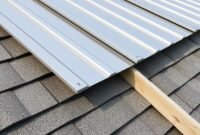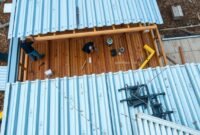Metal roofing installation represents a significant investment for any homeowner, offering durability and enhanced protection. However, like any construction, its robustness hinges on the details. The screws, though small, play a pivotal role.
Their strategic placement affects the stability and longevity of metal roofing panels, ensuring the metal sheeting remains weather-tight and secure.
Incorrectly positioned screws can lead to issues like leaks, rust, and even structural damage. Thus, ensuring the right screw placement in a metal roof is essential for your home to remain safe, dry, and protected.
Read also: The Truth about Clay Tile Roof Lifespan
Where is the Metal Roof Screw Placement?
For optimal screw placement, screws should be installed within the flat area of the panel rather than at the highest point of the rib. As an experienced installer, I’ve observed that placing screws on the rib’s crest can often result in improper sealing. This may lead to tilted screws and enlarged fastener holes over time, reducing the roof’s overall integrity.
By positioning the screws on the flat sections, you ensure a more secure attachment to the substrate, reducing the risk of water penetration and wind uplift, which aligns with best practices for metal roof installations.
When this happens, the hole enlarges and breaks the washer’s seal. Moreover, placing screws on the rib’s top heightens the risk of them pulling out during high winds. The ideal location offers a solid wood surface beneath the panel, ensuring the screws are securely fastened.

Is It Necessary to Replace Screws in an Existing Metal Roof?
Over time, screws may loosen due to the natural expansion and contraction of the roof material. From my own experience of installing metal roofs in various climates, I have noticed that screws can become dislodged, particularly in areas with significant temperature fluctuations.
This can happen even if the screws are specifically designed to resist bending. Regular inspection and maintenance are crucial to detect such issues early on and prevent potential leaks.
Regular inspections and timely maintenance are crucial in fastening metal roofing securely to withstand various weather conditions.
If you notice any loose screws or signs of moisture intrusion, it might be time to consider replacing them. Regular inspections can help identify potential issues before they escalate.
How Do You Secure a Metal Roof Effectively?
Know the essential steps to ensure your metal roof stands strong for years. Here’s the detail:
● Use the Right Equipment
The quality and type of screws are pivotal in ensuring the durability of a metal roof. Having personally replaced countless loose or damaged screws on metal roofs, I always recommend using metal-to-wood or metal-to-metal screws, depending on the roof’s substrate.
Self-tapping screws with appropriate washers create a weather-tight seal. Still, it’s essential to ensure that the screws are long enough to penetrate the roofing material and the underlying wood or metal substrate to maintain the roof’s integrity against wind uplift and water intrusion.
These specialized screws are crafted to penetrate metal sheeting effortlessly without the need for pre-drilled holes, creating a weather-tight seal that enhances the overall resilience of the roof.
When compressed correctly, the accompanying thin washers form a watertight seal, preventing moisture intrusion. This combination ensures the roof panels are firmly anchored, reducing the risk of them getting loose or blown away during adverse weather conditions.
● Avoid Over-tightening
While it might seem that the tighter the screw, the more secure the roof, this isn’t always the case. Over-tightening screws can lead to several issues. Primarily, it can overcompress the washer, leading to premature wear or breakage.
Moreover, excessive force can distort the metal panels, affecting their alignment and overall appearance.
● Avoid Under-tightening
Equally important is avoiding under-tightening screws. In my experience, a screw that is not tightened enough fails to compress the washer adequately, creating gaps that allow water to seep in. I have found that leaks and rust often originate from such issues.
Applying enough torque to compress the washer without over-stressing it is crucial to prevent this. This technique ensures a secure fit without causing material damage.
Additionally, under-tightened screws can easily work themselves out over time, especially during the roof’s natural expansion and contraction due to temperature changes.
● Ensure Straight Placement
Screws should be seated straight and flush against the surface. Any deviation, like an angled or tilted screw, can compromise the washer’s seal.
This not only increases the potential for leaks but also weakens the overall hold of the screw. A straight placement ensures that the screw, washer, and panel work harmoniously, providing maximum protection.
Read also: Plywood vs OSB for Roofing, Cost, Strength and Screw Holding
● Follow the Manufacturer’s Instructions
Every metal roofing system comes with specific guidelines from the manufacturer. Adhere to these instructions. Manufacturers have tested their products extensively and provide recommendations based on optimal performance and longevity.
It’s essential to remember that while general practices are standard, specific roofing systems might have unique requirements to address.
Read also: 7 Benefits of Applying Burnished Slate Metal Roof
By understanding and implementing best practices, you can enjoy the myriad benefits of metal roofing without worrying about frequent maintenance or issues.
| Guideline | Description | Personal Experience Insight |
|---|---|---|
| Placement on Flat Area | Screws should be placed in the flat areas of the panel rather than on the rib’s crest. | Placing screws on flat areas provides a better seal and reduces the risk of water penetration. |
| Screw Tightening | Screws must not be over-tightened or under-tightened to avoid damage or leaks. | Correct tightening avoids over-compression or under-compression of washers, ensuring longevity. |
| Inspection and Maintenance | Regular checks for loose screws or signs of rust and moisture intrusion are necessary. | Regular inspections help identify and address potential problems early, preventing costly repairs. |


